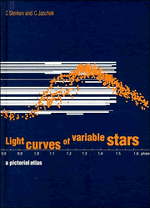Book contents
- Frontmatter
- Contents
- List of contributors
- Preface
- Acknowledgements
- Journal abbreviations
- Acronyms and abbreviations
- 1 Introduction
- 2 Eruptive variables
- 3 Pulsating variables
- 4 Rotating variables
- 5 Cataclysmic (explosive and nova-like) variables
- 6 Eclipsing binary systems
- 7 X-Ray binaries
- References
- Addresses of interest
- Appendix: Tables
- Illustration credits
- Object index
- Subject index
5 - Cataclysmic (explosive and nova-like) variables
Published online by Cambridge University Press: 23 November 2009
- Frontmatter
- Contents
- List of contributors
- Preface
- Acknowledgements
- Journal abbreviations
- Acronyms and abbreviations
- 1 Introduction
- 2 Eruptive variables
- 3 Pulsating variables
- 4 Rotating variables
- 5 Cataclysmic (explosive and nova-like) variables
- 6 Eclipsing binary systems
- 7 X-Ray binaries
- References
- Addresses of interest
- Appendix: Tables
- Illustration credits
- Object index
- Subject index
Summary
Supernovae
A supernova explosion is a rare type of stellar explosion which dramatically changes the structure of a star in an irreversible way. Large amounts of matter (one to several solar masses) are expelled at high velocities (several tens of thousands km s-1). The light curve in the declining part is powered by thermalized quanta, released by the radioactive decay of elements produced in the stellar collapse, mainly 56Co and 56Ni. The ejected shell interacts with the interstellar medium and forms a SN remnant, which can be observed long after the explosion in the radio, optical and X-ray regions.
Supernovae can be divided into two classes (and several subclasses), viz. SN I and SN II.
SN I have fairly similar light curves (see, for example, Fig. 5.1) and display a small spread in absolute magnitudes. Spectra around maximum show absorption lines of Ca II, Si II and He I, but lack lines of hydrogen. They occur in intermediate and old stellar populations. Their progenitor stars are not clearly identified, but massive white dwarfs (WDs) that accrete matter from a close companion and are pushed over the Chandrasekhar limit are good candidates. Another possibility is the hypothesis of the fusion of a binary consisting of two WDs. The collapse of the white dwarf leads in both cases to an explosive burning of its carbon, and the released energy is sufficient to trigger a disintegration of the complete object.
- Type
- Chapter
- Information
- Light Curves of Variable StarsA Pictorial Atlas, pp. 129 - 167Publisher: Cambridge University PressPrint publication year: 1996



